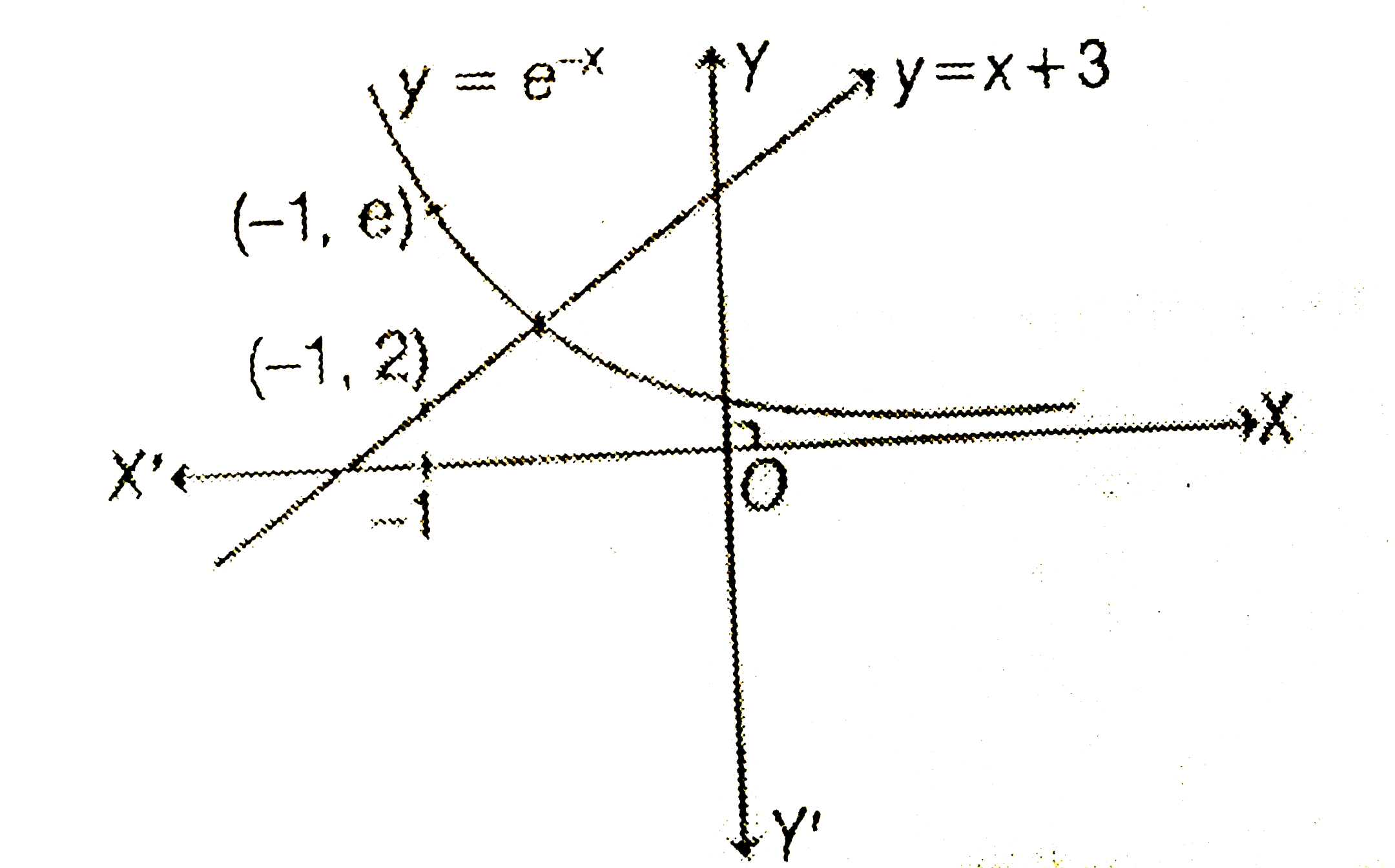Let y(x) be a solution of the differential equation (1+ex)y′+yex=1. If y(0)=2 , then which of the following statements is (are) true? (a) (b)(c)y((d)(e)−4(f))=0(g) (h) (b) (i)(j)y((k)(l)−2(m))=0(n) (o) (c) (d)(e)y((f)x(g))(h) (i) has a critical point in the interval (j)(k)((l)(m)−1,0(n))(o) (p) (q) (r)(s)y((t)x(u))(v) (w) has no critical point in the interval (x)(y)((z)(aa)−1,0(bb))(cc) (dd)Solution in Tamil
(a) Y(−4)=0
(b) Y(−2)=0
(c) y(x) has a critical point in the intervel (-1,0)
(d) y(x) has no critical point in the interval (-1,0)
The correct Answer is:(a,c)
Here, (1+ex)y'+yex=1
⇒dydx+ex⋅dydx+yex=1
⇒dy+exdy+yexdx=dx
⇒dy+d(exy)=dx
On integrating voth sides, we get
y+exy=x+C
Given, y(0)=2
⇒2+e0⋅2=0+C
⇒C=4
∴y(1+ex)=x+4
⇒y=x+41+ex
Now at x=−4,y=−4+41+e−4=0
∴y(−4)=0...(i)
For critical points, dydx=0
i.e. dydx=(1+ex)⋅1−(x+4)ex(1+ex)2=0
⇒ex(x+3)−1=0
or e−x=(x+3)
Clearly, the intersection point lies between (-1,0).
∴y(x) has a critical point in the interval (-1,0).

Similar Questions
The differential equation whose general solution is given by y=(c1cos(x+c2)−(c3e(−x+c4)+(c5sinx), where c1,c2,c3,c4,c5 are arbitrary constants, is (a) (b)(c)(d)(e)(f)d(g)4(h)(i)yj((k)d(l)x(m)4(n)(o))(p)(q)−(r)(s)(t)d(u)2(v)(w)yx((y)d(z)x(aa)2(bb)(cc))(dd)(ee)+y=0(ff) (gg) (hh) (ii)(jj)(kk)(ll)(mm)d(nn)3(oo)(pp)yqq((rr)d(ss)x(tt)3(uu)(vv))(ww)(×)+(yy)(zz)(aaa)d(bbb)2(ccc)(ddd)yeee((fff)d(ggg)x(hhh)2(iii)(jjj))(kkk)(lll)+(mmm)(nnn)dyooo((ppp)dx)(qqq)(rrr)+y=0(sss) (ttt) (uuu) (vvv)(www)(×x)(yyy)(zzz)d(aaaa)5(bbbb)(cccc)dddd((eeee)d(ffff)x(gggg)5(hhhh)(iiii))(jjjj)(kkkk)+y=0(llll) (mmmm) (nnnn) (oooo)(pppp)(qqqq)(rrrr)(ssss)d(tttt)3(uuuu)(vvvv)ywwww((xxxx)d(yyyy)x(zzzz)3(aaaaa)(bbbbb))(ccccc)(ddddd)−(eeeee)(fffff)(ggggg)d(hhhhh)2(iiiii)(jjjjj)ykkkkk((lllll)d(mmmmm)x(nnnnn)2(ooooo)(ppppp))(qqqqq)(rrrrr)+(sssss)(ttttt)dyuuuuu((vvvvv)dx)(wwwww)(××x)−y=0(yyyyy) (zzzzz)
View SolutionThe solution of the differential equation x=1+xydydx+x2y22!(dyd)2+x3y33!(dydx)3+is (a) (b)(c)y=1n((d)x(e))+c(f) (g) (b) (h)(i)(j)y(k)2(l)(m)=(n)(o)((p)(q)1nx(r))(s)2(t)(u)+c(v) (w) (c) (d)(e)y=logx+xy(f) (g) (d) (h)(i)xy=(j)x(k)y(l)(m)+c(n) (o)
View SolutionThe solution of the differential equation dydx=3x2y4+2xyx2−2x3y3 is (a) (b)(c)(d)(e)(f)y(g)2(h)(i)jx(k)(l)−(m)x(n)3(o)(p)(q)y(r)2(s)(t)=c(u) (v) (w) ( x ) (y) (z)(( a a ) (bb) x^(( c c )2( d d ))( e e ))/( f f )(( g g ) (hh) y^(( i i )2( j j ))( k k ))( l l ) (mm)+( n n ) x^(( o o )3( p p ))( q q ) (rr) y^(( s s )3( t t ))( u u )=c (vv) (ww) (xx) (yy)(zz)(aaa)(bbb)(c)x(ddd)2(eee)(fff)gggy(hhh)(iii)+(jjj)x(kkk)3(lll)(mmm)(⋂)y(ooo)2(ppp)(qqq)=c(rrr) (sss) (d) (ttt)(⋃)(⋁)(www)(×x)x(yyy)2(zzz)(aaaa)bbbb((cccc)3y)(dddd)(eeee)−2(ffff)x(gggg)3(hhhh)(iiii)(jjjj)y(kkkk)2(llll)(mmmm)=c(⋂n) (oooo)
View SolutionThe solution of the differential equation (x2y2−1)dy+2xy3dx=0 is (a) (b)(c)1+(d)x(e)2(f)(g)(h)y(i)2(j)(k)=cx(l) (m) (b) (n)(o)1+(p)x(q)2(r)(s)(t)y(u)2(v)(w)=cy(x) (y) (c) (d)(e)y=0(f) (g) (d) (h)(i)y=−(j)1k((l)(m)x(n)2(o)(p))(q)(r)(s) (t)
View SolutionLet y(x) be a solution of the differential equation (1+ex)y′+yex=1. If y(0)=2 , then which of the following statements is (are) true? (a) (b)(c)y((d)(e)−4(f))=0(g) (h) (b) (i)(j)y((k)(l)−2(m))=0(n) (o) (c) (d)(e)y((f)x(g))(h) (i) has a critical point in the interval (j)(k)((l)(m)−1,0(n))(o) (p) (q) (r)(s)y((t)x(u))(v) (w) has no critical point in the interval (x)(y)((z)(aa)−1,0(bb))(cc) (dd)
View SolutionThe solution of the differential equation dydx+1=ex+y, is a. (x+y)ex+y=0 b. (x+C)ex+y=0 c. (x−C)ex+y=1 d. (x+C)ex+y+1=0
View SolutionThe general solution of the differential equation ex dy + (y ex + 2x) dx = 0 is
(A) xey+x2=C (B) xey+y2=C (C) yex+x2=C (D) yey+x2=C
View SolutionLet y=f(x) is a solution of differential equation ey(dydx−1)=ex and f(0)=0 then f(1) is equal to
View Solution
